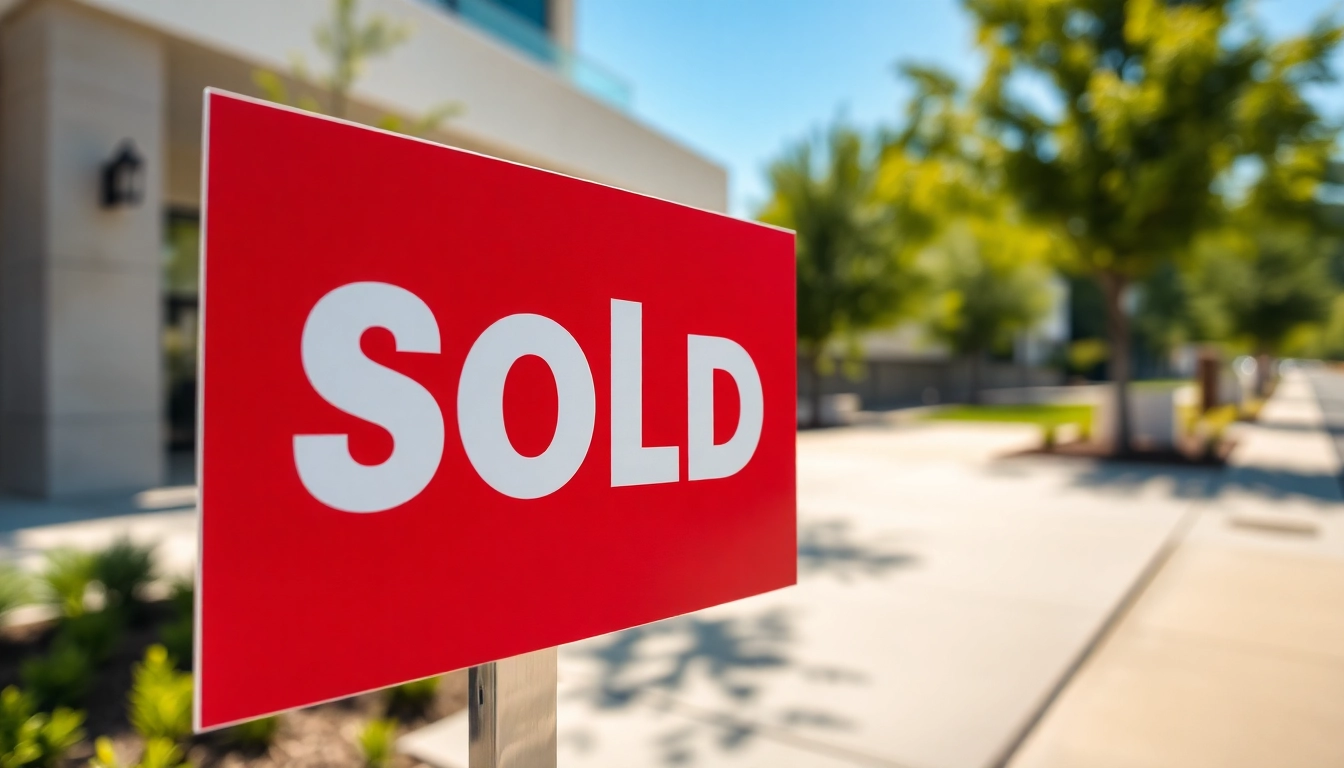Understanding the Importance of a Well-Designed Sold Sign
In the competitive real estate market, visual advertising plays a pivotal role in attracting potential buyers and closing sales efficiently. Among various marketing tools, a prominently displayed sold sign remains one of the most effective and enduring symbols of a successful property transaction. A well-designed sold sign not only announces the sale but also enhances the agent’s brand visibility, instills confidence in prospective clients, and fosters trust in your professional capabilities. This section delves into why investing in a professional, attractive sold sign boosts property visibility and how it impacts your overall branding strategy.
The primary purpose of a sold sign is to communicate that a property has been successfully sold or is under contract. But beyond this basic function, a crafted, professional appearance significantly amplifies its effectiveness. When a potential buyer or neighbor passes by, an eye-catching, credible sold sign acts as a visual endorsement of your expertise and reliability. It subtly communicates that you are active, successful, and capable of closing deals effectively, which can lead to more referrals and future listings.
Numerous studies in marketing emphasize the importance of visual cues in decision-making. For real estate agents, this means a high-quality sold sign that looks professional and trustworthy can influence perceptions of your brand’s credibility. Moreover, the clarity and visibility of the sign ensure that your contact details are easily noticed, prompting potential clients to reach out. Remember, the goal isn’t just to inform but to impress and persuade, making the quality of your sold sign a strategic asset.
Key Features of Effective Sold Signs
Clear Visibility and Readability
An effective sold sign is instantly recognizable from a distance. This requires bold typography, contrasting colors, and a clean layout. Use large, legible fonts that can be read from several yards away; avoid clutter or overly decorative fonts that hamper readability. Two-sided graphics can further enhance visibility, especially for signs placed in high-traffic areas or at corners.
Concise and Impactful Messaging
The message should be straightforward — typically, “SOLD” coupled with essential contact details or branding. Additional information, such as “Under Contract” or “Pending,” can be used strategically during different transaction stages. Keep text minimal to avoid confusion and ensure quick comprehension by viewers.
Brand Consistency and Recognition
Incorporate elements that reinforce your personal or agency brand, such as logos, color schemes, and taglines. Consistent branding across your signs helps establish recognition and trust in local markets. For example, if your brand colors are blue and white, use these colors prominently to make your signs instantly identifiable.
Durability and Material Quality
A sold sign must withstand outdoor conditions over extended periods without fading or deteriorating. High-quality materials ensure longevity and provide a professional look, reinforcing your credibility. Investing in durable signs pays off by reducing replacement costs and maintaining a polished appearance.
Legal and Local Considerations
Always ensure your signage complies with local regulations regarding size, placement, and messaging. Some neighborhoods or municipalities have restrictions on signage, so familiarizing yourself with these rules prevents legal issues and ensures your signs are displayed correctly.
Materials and Durability for Long-Lasting Impact
Top Materials Used in High-Quality Sold Signs
The choice of material significantly impacts the longevity and appearance of sold signs. Common materials include corrugated plastic (coroplast), aluminum, wood, and vinyl banners. Corrugated plastic is lightweight, weather-resistant, and affordable, making it a popular choice for outdoor signage. Aluminum signs are sturdy and rust-proof, offering high durability for long-term displays. Wooden signs provide a traditional aesthetic, often used for decorative or boutique-style branding, but require maintenance to withstand weather elements.
Weather Resistance and Outdoor Durability
An outdoor sold sign faces exposure to rain, sun, wind, and temperature fluctuations. High-quality signs feature UV-resistant inks, waterproof materials, and sturdy mounting options to prevent fading, warping, or damage. For instance, signs printed on weatherproof vinyl with laminated finishes can retain vibrancy and clarity over years of outdoor use. Proper installation, such as securely anchoring posts or using durable mounting hardware, further enhances longevity.
Choosing Eco-Friendly and Reusable Options
Sustainability is increasingly vital in marketing materials. Eco-friendly sold signs utilize recyclable or biodegradable materials, low-VOC inks, and manufacturing processes with minimal environmental impact. Reusable signs, such as magnetic or clip-on displays, allow you to update messages without disposal and fit multiple properties or different statuses. These options reduce waste and demonstrate your commitment to environmentally responsible practices, appealing to eco-conscious clients.
Customization and Branding: Making Your Sign Stand Out
Incorporating Logos and Contact Info
Your sold sign should serve as a mobile billboard for your brand. Including a professionally designed logo ensures instant recognition and associates your success with quality. Contact information, such as phone number, website, or social media handles, should be displayed clearly, facilitating easy follow-up by potential clients. Consider adding QR codes linked to your online profiles for tech-savvy viewers.
Color Schemes and Visual Cues for Attention
Colors evoke emotions and grab attention. Bright, contrasting hues like red, yellow, or orange are effective for standing out in diverse environments. Incorporate visual cues such as arrows pointing towards the property, icons, or symbols to guide viewers’ attention. Consistent use of your brand’s color palette reinforces recognition and cohesiveness across marketing materials.
Personalization Tips for Effective Marketing
Personalized signs—featuring specific property details, client names, or custom messages—can make your signage more memorable. Unique design elements like handwritten signatures or bespoke illustrations create a distinctive look. However, always balance personalization with clarity and professionalism to maintain credibility.
Placement Strategies for Maximum Exposure
Optimal Locations for Installing Sold Signs
Strategic location is critical. Place signs at key points such as the front yard, busy intersections, or high-traffic corridors where they can be easily seen by pedestrians and drivers. Ensure signs are not obstructed by trees, parked vehicles, or other structures. For properties on larger lots, directional signage at entrances or along driveways can extend visibility.
Timing and Frequency of Sign Updates
Update your signage promptly once a property sells or goes pending to reflect the latest status. Frequent changes demonstrate active marketing efforts and professionalism. Additionally, using temporary or removable signs allows flexibility for seasonal or market-related adjustments, while reusable signs can be updated quickly with new messages.
Legal Considerations and Local Regulations
Different municipalities have regulations regarding sign placement, size, and permitted hours. Always check local ordinances before installation to avoid fines or removal. Some communities restrict signage in certain zones or require permits. Partnering with local authorities or using professional signage providers can streamline compliance and ensure your signs are strategically placed within legal boundaries.
Measuring Success and Leveraging Sold Signs to Generate Leads
Tracking Property Status and Customer Engagement
Establishing a tracking system for properties marked with sold signs helps gauge marketing effectiveness. Record details such as sign placement date, property details, and subsequent client inquiries. Analyzing trends—like which locations or sign designs attract more attention—inform future strategies. Digital tools or CRM integrations can automate tracking and follow-up processes.
Integrating Sold Signs with Broader Marketing Campaigns
Sold signs should be part of a comprehensive marketing approach. Incorporate QR codes linked to virtual tours, testimonials, or your website. Use social media to showcase new sales with images of sold signs, boosting your online visibility. Cross-promote with email campaigns or neighborhood outreach to create a cohesive presence.
Client Testimonials and Case Studies
Sharing success stories where well-designed sold signs contributed to quick sales or increased listing opportunities builds credibility. Include real-world examples of how strategic signage influenced buyer perception or facilitated referrals. Positive client testimonials reinforce your reputation as a proactive and professional agent.



